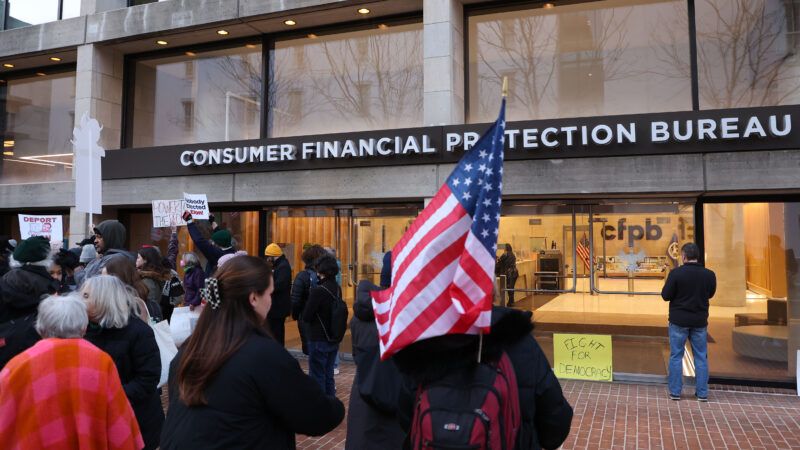Consumer Financial Protection Bureau
How the CFPB's Medical Debt Rule Could Backfire
Scrubbing credit reports won’t erase debt—it will just make borrowing harder for low-income Americans.

On February 7, 2025, President Donald Trump appointed Russell Vought to head the Consumer Financial Protection Bureau (CFPB). Shortly after, Vought announced that he had notified the Federal Reserve that the CFPB would not take its next draw of unappropriated funding. "This spigot, long contributing to CFPB's unaccountability, is now being turned off."
The CFPB has long overstepped its authority. Its latest effort to regulate medical debt and credit reporting is a prime example.
In response to Trump's executive order freezing all regulations, the CFPB immediately started searching for ways to circumvent the order and push forward its policy agenda. When its rule banning medical debt from credit reports was stopped in its tracks, the agency appealed to state legislatures to pass laws doing just that.
The CFPB first proposed this rule in summer 2024. Hundreds of people—including the authors of this piece—submitted public comments in opposition to the proposed rule. While it aimed to increase access to credit for those with medical debt, it would have the opposite effect.
The rule creates "information asymmetry," where borrowers would have more information than lenders. Aware of the existence of that imbalance, lenders might fear "adverse selection," where borrowers conceal debt to their advantage.
This could lead lenders to impose higher interest rates, tighten lending standards, or leave the marketplace altogether. As lenders exit, competition decreases, raising borrowing costs and reducing credit availability—to the detriment of borrowers.
Low-income Americans would be hit the hardest. CFPB research shows medical debt is most prevalent among Americans earning less than $50,000 per year. The U.S. Census Bureau found that households earning less than $25,000 per year have the highest rates of medical debt. Wiping medical debt off credit reports does not mean lenders will ignore those stats.
Instead, lenders may assume low-income applicants have undisclosed medical debt. In response, lenders will likely increase their borrowing rates to compensate for a lack of information, offer lower borrowing rates if medical debt is voluntarily disclosed, or choose to stop lending to low-income borrowers altogether. If credit access shrinks, vulnerable Americans may turn to black market lenders.
Similar results followed the CFPB's regulations on payday lenders. In 2016, the CFPB proposed a rule under the Dodd-Frank Act to regulate payday lenders—despite the fact that these lenders were already regulated by state law. Research overwhelmingly showed that existing state regulations on payday lenders limited low-income Americans' access to credit, leading the CFPB to delay the rule's implementation in 2019 and withdraw the rule in 2020. It did, however, issue a rule regulating "junk fees" that will likely result in low-income Americans losing access to credit.
Mortgage servicing regulations provide another cautionary tale. In January 2014, the CFPB implemented stricter reporting standards for adjustable-rate mortgages, periodic loan statements, mortgage payment processing, and payoff requests. While it aimed to protect homeowners, these rules disproportionately burdened community banks—key lenders for small towns, rural areas, and urban neighborhoods.
While a study from the Government Accountability Office (GAO) characterized the effect of the regulations as modest, it admitted that loan availability data remained incomplete. The GAO did find that the number of community banks declined by 24 percent due to mergers among community banks and a decline in new bank formation.
While lending among the remaining consolidated community banks increased, it grew at a slower rate due to regulatory compliance costs. Other research determined that merger-induced bank closures significantly decreased access to credit, especially in rural areas. Compliance costs, often framed as consumer protection, ultimately restrict competition and limit consumer choice.
Despite previous lessons, the CFPB issued the medical debt rule in the final days of the Biden-Harris administration. Instead of heeding Trump's executive order to freeze and review the pending rule, the agency sought an alternative route.
On January 28, the CFPB sent letters to the state legislatures of Massachusetts, Oregon, South Dakota, and Washington in support of proposed bills that would remove medical debt from credit reports. While the CFPB may be acting within legal boundaries, it is a move that not only highlights bureaucratic overreach, but sets a dangerous precedent. When federal agencies view executive orders as obstacles to sidestep rather than directives to follow, governance shifts from elected officials to unaccountable bureaucrats.
The CFPB should revoke this rule before it takes effect. Likewise, state legislators should carefully examine the unintended consequences of removing medical debt from credit reports.


Show Comments (12)